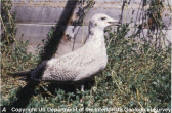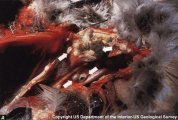|
Apergillosis |
 |
 |
|
| |
| Causative Agent |
-
A disease of the respiratory tract, primarily occurring in birds. It is
caused by a
fungus, Aspergillus,
usually A. fumigatus.
-
Aspergillus
fungi live on dead or decaying
matter that are closely related to human activities such as decaying
vegetation and feed grains.
|
| Images |
|
Click on images to enlarge. |
 |
 |
|
Labored breathing and
‘gaping’ are often observed in birds suffering from
aspergillosis. |
Lung of bird with chronic
aspergillosis showing cheese-like fungal plaques (at arrows). |
|
| Distribution |
|
Geographic: |
|
|
|
Seasonality: |
-
Outbreaks of aspergillosis in waterfowl occur usually in the fall and
early winter.
-
Individual cases of aspergillosis can occur throughout the year,
particularly among birds undergoing stress such as
malnutrition or suffering
from another disease.
|
|
| Hosts, Transmission and Life
Cycle |
| Hosts: |
-
Aspergillosis is most often encountered in birds; rarely in mammals.
All birds are susceptible to
aspergillosis. It is most commonly observed in colonial
waterbirds (gulls), waterfowl, ravens and crows (corvids),
and captive birds of prey.
-
In young birds, particularly
in species of northern waterfowl (eiders, mergansers),
infection may spread (become generalized) and affect the
brain.
|
|
Transmission and Life Cycle: |
-
Aspergillus
spores are ubiquitous in the
environment and are frequently inhaled by vertebrates.
-
Spores
travel through the upper
respiratory tract to the lungs where they may colonize and
produce a
fungal
pneumonia. The lungs become
obliterated with debris and
fungal filaments.
-
Air sacs, parts of avian
respiratory systems located primarily in the abdomen and
long bones of wings, may also become infected. Dispersal of
fungi to organs adjacent to air
sacs may also occur.
-
Aspergillosis is not usually
considered
contagious.
|
|
| Signs and Symptoms |
-
Typically, birds infected with
Aspergillus will be
emaciated, exhibiting severe
difficulty in breathing. Infected birds also appear
unthrifty and weak, their wings may droop, and they may fail in
attempts to escape if pursued.
-
Infection that has reached
the brain can result in loss of muscular coordination and twisting
of the head and neck so they are held in unnatural positions.
-
Variably sized
lesions in the lungs and air sacs
are often visible in
chronic infections of
aspergillosis, occurring as flattened, yellow
plaques with a cheese-like
appearance and consistency.
-
Similarly, large masses of
fungal growth resembling bread mold may line air sacs.
|
| Meat Edible? |
-
Birds with aspergillosis should not be considered edible because they are
often in poor body condition. While it is not possible for humans to
contract aspergillosis from eating the meat of an infected bird, it
is possible for humans to contract this disease from inhaling the
spores that are present in the air
sacs and lungs. Because of this, infected birds should be discarded
and not consumed.
|
| Human Health Concerns and
Risk Reduction |
-
Aspergillosis is considered a
zoonotic disease. If resistance to
infection is impaired, inhalation of Aspergillus
spores may lead to
fungal
pneumonia or a serious allergic
reaction to the
fungus.
|
| Samples for Diagnosis |
-
The whole carcass
should be submitted for
necropsy.
The presence of
fungal infection can be confirmed microscopically in the
laboratory.
|
| Similar Diseases |
|
|
| Further Reading |
|
|
|
|



